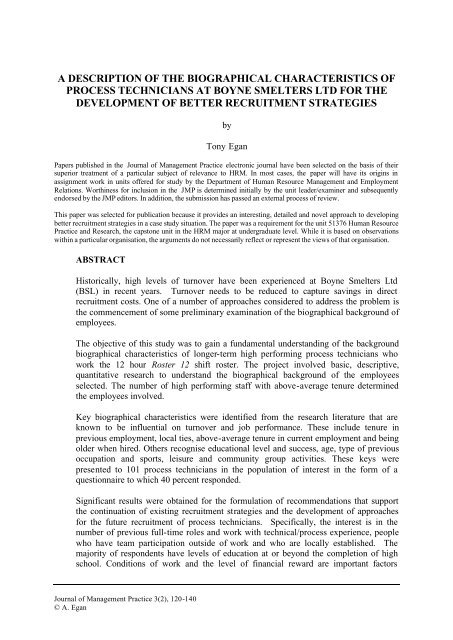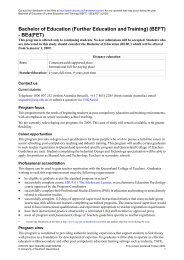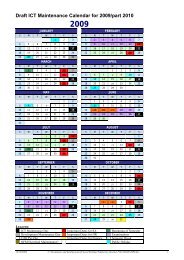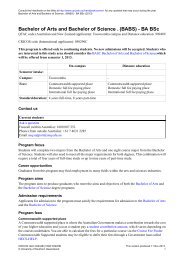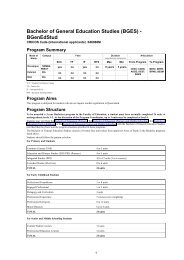a description of the biographical characteristics of process
a description of the biographical characteristics of process
a description of the biographical characteristics of process
Create successful ePaper yourself
Turn your PDF publications into a flip-book with our unique Google optimized e-Paper software.
A DESCRIPTION OF THE BIOGRAPHICAL CHARACTERISTICS OFPROCESS TECHNICIANS AT BOYNE SMELTERS LTD FOR THEDEVELOPMENT OF BETTER RECRUITMENT STRATEGIESbyTony EganPapers published in <strong>the</strong> Journal <strong>of</strong> Management Practice electronic journal have been selected on <strong>the</strong> basis <strong>of</strong> <strong>the</strong>irsuperior treatment <strong>of</strong> a particular subject <strong>of</strong> relevance to HRM. In most cases, <strong>the</strong> paper will have its origins inassignment work in units <strong>of</strong>fered for study by <strong>the</strong> Department <strong>of</strong> Human Resource Management and EmploymentRelations. Worthiness for inclusion in <strong>the</strong> JMP is determined initially by <strong>the</strong> unit leader/examiner and subsequentlyendorsed by <strong>the</strong> JMP editors. In addition, <strong>the</strong> submission has passed an external <strong>process</strong> <strong>of</strong> review.This paper was selected for publication because it provides an interesting, detailed and novel approach to developingbetter recruitment strategies in a case study situation. The paper was a requirement for <strong>the</strong> unit 51376 Human ResourcePractice and Research, <strong>the</strong> capstone unit in <strong>the</strong> HRM major at undergraduate level. While it is based on observationswithin a particular organisation, <strong>the</strong> arguments do not necessarily reflect or represent <strong>the</strong> views <strong>of</strong> that organisation.ABSTRACTHistorically, high levels <strong>of</strong> turnover have been experienced at Boyne Smelters Ltd(BSL) in recent years. Turnover needs to be reduced to capture savings in directrecruitment costs. One <strong>of</strong> a number <strong>of</strong> approaches considered to address <strong>the</strong> problem is<strong>the</strong> commencement <strong>of</strong> some preliminary examination <strong>of</strong> <strong>the</strong> <strong>biographical</strong> background <strong>of</strong>employees.The objective <strong>of</strong> this study was to gain a fundamental understanding <strong>of</strong> <strong>the</strong> background<strong>biographical</strong> <strong>characteristics</strong> <strong>of</strong> longer-term high performing <strong>process</strong> technicians whowork <strong>the</strong> 12 hour Roster 12 shift roster. The project involved basic, descriptive,quantitative research to understand <strong>the</strong> <strong>biographical</strong> background <strong>of</strong> <strong>the</strong> employeesselected. The number <strong>of</strong> high performing staff with above-average tenure determined<strong>the</strong> employees involved.Key <strong>biographical</strong> <strong>characteristics</strong> were identified from <strong>the</strong> research literature that areknown to be influential on turnover and job performance. These include tenure inprevious employment, local ties, above-average tenure in current employment and beingolder when hired. O<strong>the</strong>rs recognise educational level and success, age, type <strong>of</strong> previousoccupation and sports, leisure and community group activities. These keys werepresented to 101 <strong>process</strong> technicians in <strong>the</strong> population <strong>of</strong> interest in <strong>the</strong> form <strong>of</strong> aquestionnaire to which 40 percent responded.Significant results were obtained for <strong>the</strong> formulation <strong>of</strong> recommendations that support<strong>the</strong> continuation <strong>of</strong> existing recruitment strategies and <strong>the</strong> development <strong>of</strong> approachesfor <strong>the</strong> future recruitment <strong>of</strong> <strong>process</strong> technicians. Specifically, <strong>the</strong> interest is in <strong>the</strong>number <strong>of</strong> previous full-time roles and work with technical/<strong>process</strong> experience, peoplewho have team participation outside <strong>of</strong> work and who are locally established. Themajority <strong>of</strong> respondents have levels <strong>of</strong> education at or beyond <strong>the</strong> completion <strong>of</strong> highschool. Conditions <strong>of</strong> work and <strong>the</strong> level <strong>of</strong> financial reward are important factorsJournal <strong>of</strong> Management Practice 3(2), 120-140© A. Egan
Biographical Characteristics <strong>of</strong> Process TechniciansEganinfluencing respondents’ inclination to leave <strong>the</strong> organisation. Recruitment outside <strong>the</strong>area should have more emphasis on <strong>the</strong> quality <strong>of</strong> life available in <strong>the</strong> region.INTRODUCTIONBoyne Smelters Ltd (BSL) is in business to produce primary aluminum products for worldand domestic markets. The plant was established in <strong>the</strong> early 1980s and underwent expansionin 1997 to almost double its output — to make it one <strong>of</strong> <strong>the</strong> largest aluminum smelters in <strong>the</strong>world. Comalco holds 51 percent ownership in BSL and has <strong>the</strong> operational managementaccountabilities. Comalco is itself a company within <strong>the</strong> Rio Tinto Group. Boyne Smeltersemploys around 1200 people at its Boyne Island site near <strong>the</strong> beach-side ‘twin-towns’ <strong>of</strong>Boyne Island and Tannum Sands which has a population <strong>of</strong> about 7,000 people. Thecommunity and plant are about 22 kilometres by road from <strong>the</strong> industrial port city <strong>of</strong>Gladstone, which has a population <strong>of</strong> approximately 30,000 people.Recent history at Boyne Smelters indicates significant reductions need to be made inemployee turnover to decrease direct recruitment costs. Voluntary turnover stood at 10-14percent in 1999 across site. In recent years, overall turnover has been in excess <strong>of</strong> 20 percent(see Table 1 below). The Process Enhancement Program (PEP) conducted at BSL during1998 revealed <strong>the</strong> need to reduce <strong>the</strong> level <strong>of</strong> employee turnover and capture considerablesavings in direct recruitment costs. During PEP, team members identified a pathway andoutlined an implementation plan for achieving <strong>the</strong> recruitment savings.The PEP program identified annual savings <strong>of</strong> $420,000 in direct recruitment costs for everytwo percent reduction in overall turnover. This includes advertising, interviews, removal,accommodation, induction, initial training and relocation allowances. In <strong>the</strong> 1998 cost baseyear, it amounted to 26 roles annually from all levels in <strong>the</strong> organisation, or $16000 per role.Gaining a better understanding <strong>of</strong> <strong>the</strong> <strong>biographical</strong> background <strong>of</strong> longer-term employees atBSL has been suggested by <strong>the</strong> PEP <strong>process</strong> as one among a number <strong>of</strong> strategies to improve<strong>the</strong> <strong>process</strong> <strong>of</strong> attracting and retaining staff.This project will focus on an initial examination <strong>of</strong> <strong>the</strong> <strong>biographical</strong> <strong>characteristics</strong> <strong>of</strong> longertermstaff in <strong>process</strong> technician roles that work <strong>the</strong> 12-hour (Roster 12) shift roster to provideinformation to assist <strong>the</strong> development <strong>of</strong> better recruitment <strong>process</strong>es. This group <strong>of</strong>employees was chosen because it is <strong>the</strong> largest group on site and is made up <strong>of</strong> roles thatperform <strong>process</strong> and production work <strong>of</strong> similar type and complexity. It is also <strong>the</strong> group thatdemands <strong>the</strong> largest recruitment by volume on an annual basis and has an unusually high level<strong>of</strong> turnover. Also, because <strong>of</strong> its size, it produced <strong>the</strong> largest number <strong>of</strong> long term and higherperforming employees for <strong>the</strong> purpose <strong>of</strong> obtaining a population <strong>of</strong> sufficient size for <strong>the</strong>research requirements.BACKGROUNDIn May 1996 <strong>the</strong> company moved to an all-staff workforce and individual contracts based on<strong>the</strong> approval <strong>of</strong> an enterprise flexibility agreement for <strong>the</strong> site. This appears to have made animpact on voluntary turnover as shown in Figure. 1, but turnover has remained high. At <strong>the</strong>same time, Boyne Smelters introduced a system <strong>of</strong> performance based salaries by adopting<strong>the</strong> Comalco system <strong>of</strong> Work Performance Review (WPR) and Work PerformanceAssessment (WPA) conducted annually. Each staff member is assessed by <strong>the</strong>ir immediatemanager based on <strong>the</strong>ir work performance in <strong>the</strong> relative people, programming and technical121
Journal <strong>of</strong> Management Practice Volume 3, No. 2 2000aspects <strong>of</strong> <strong>the</strong>ir role during <strong>the</strong> previous calendar year. During <strong>the</strong> same year at least one WPRmust be conducted with each staff member. The purpose <strong>of</strong> this review is to discuss <strong>the</strong>employee’s performance and that <strong>of</strong> his or her leader. Currently, WPA scores range in valuefrom 0–100, where 30 is considered a performance level that meets <strong>the</strong> minimumrequirements <strong>of</strong> <strong>the</strong> role. A score above 85 indicates a performance that continually exceeds<strong>the</strong> full requirements <strong>of</strong> <strong>the</strong> role. A new rate <strong>of</strong> salary commences in April each yearcalculated from <strong>the</strong> performance score. A score above 65 is considered indicative <strong>of</strong> a highperformingemployee. It <strong>the</strong>n follows that <strong>the</strong> company is likely to be interested in retaining<strong>the</strong>se staff.LITERATURE REVIEWDuring <strong>the</strong> research <strong>process</strong>, <strong>the</strong>oretical principles drawn from human resource management,organisational behaviour and management and <strong>the</strong> social sciences were applied as necessaryto <strong>the</strong> issues. In addition, any literature in research journals that addressed <strong>the</strong> issue <strong>of</strong>employee turnover and <strong>biographical</strong> data was examined.DefinitionOne influential review <strong>of</strong> <strong>the</strong> topic proposed that a universally accepted definition <strong>of</strong> biodatacannot be found. In this review, biodata is described essentially as information about <strong>the</strong>personal life-history and experience that an individual provides through resumes, interviews,and applications for employment. When applied to <strong>the</strong> selection <strong>process</strong> <strong>the</strong>y are presumed tobe related to success in occupational endeavours and are predictors <strong>of</strong> certain work-relatedbehaviours (Gunter, Furnham & Blakeley 1993).The literature refers to ‘hard’ and ‘s<strong>of</strong>t’ biodata. The former relates to <strong>the</strong> more factualdemographic and background information found on most application blanks and is historicaland verifiable (Nickels 1990). The latter refers to more abstract and subjective data whichinclude items <strong>of</strong> a more private nature such as judgments, motivations and expectations(Gunter et al. 1993). Many argue that only <strong>the</strong> individual’s verifiable life-history events andexperiences from work and private life should be considered as legitimate biodata. Thiscontention supports <strong>the</strong> information found on application blanks, ra<strong>the</strong>r than on an extensive<strong>biographical</strong> questionnaire that tend to focus more on <strong>the</strong> ‘s<strong>of</strong>t’ data (Gunter et al. 1993). It is<strong>the</strong> ‘hard’ data that are more applicable in this study because <strong>of</strong> <strong>the</strong> nature <strong>of</strong> <strong>the</strong> informationsought by <strong>the</strong> client and <strong>the</strong> introductory nature <strong>of</strong> <strong>the</strong> research.HistoryThe concept <strong>of</strong> <strong>biographical</strong> data (biodata) has a long history and <strong>the</strong>se data have been used asselection tools for most <strong>of</strong> this century. However, it has only been in <strong>the</strong> past ten to fifteenyears that it has been developed and considered a significant tool in employee selection andperformance prediction (Stokes 1990). It is considered a commonsense approach to futurebehaviour at work based on personal (<strong>biographical</strong>) history. Goldsmith, in 1922 (Furnham1997), was one <strong>of</strong> <strong>the</strong> earliest to use <strong>biographical</strong> data and he developed a WeightedApplication Blank (WAB) for <strong>the</strong> insurance industry. He maintained that <strong>the</strong> easiest way tomeasure past behaviour is from what appears on an application form.The simplest source <strong>of</strong> biodata is <strong>the</strong> curriculum vitae (CV) or <strong>the</strong> application form (Hammer& Kleiman 1988). The CV is considered much more informative because it allows <strong>the</strong>122
Biographical Characteristics <strong>of</strong> Process TechniciansEganapplicant <strong>the</strong> opportunity to present <strong>the</strong> material in <strong>the</strong> way <strong>the</strong>y want (Statt 1994). Thedevelopments in recent years have centred on acquiring <strong>the</strong> data via specially designedsurveys and questionnaires, ra<strong>the</strong>r than relying only on <strong>the</strong> usual information provided by <strong>the</strong>job applicant. Generally <strong>the</strong> use <strong>of</strong> biodata in this structured way is under-utilised by mostprivate sector organizations, even though it has high levels <strong>of</strong> prediction <strong>of</strong> employeebehaviour and adds to <strong>the</strong> validity and accuracy <strong>of</strong> <strong>the</strong> selection <strong>process</strong> (Mitchell 1990).EffectivenessThe reliability <strong>of</strong> biodata as a predictor <strong>of</strong> future performance is no longer in doubt. It isconsidered more reliable and more acceptable to applicants than personality tests (Furnham1997) and should be more widely accepted as an integral and reliable part <strong>of</strong> employeeselection <strong>process</strong>es (Hammer & Kleiman 1988). Studies to confirm truthfulness <strong>of</strong> responseshave correlations in excess <strong>of</strong> 0.9 (Drakeley 1989).Biodata usage has been consistent in its ability to predict such workplace issues as employeeturnover and performance. The usefulness <strong>of</strong> <strong>biographical</strong> data has always been based on <strong>the</strong>premise that generally humans will behave in <strong>the</strong> future as <strong>the</strong>y have in <strong>the</strong> past, even though<strong>the</strong> causal influences are unknown (Mael 1991; Kuhnert & Russell 1990; Pannone 1990). Itappears from <strong>the</strong> literature that <strong>the</strong> reasons why biodata are predictive is less important than<strong>the</strong> fact that it is (Furnham 1991).The events that occur in a person’s life can predict vocational choice through an individual’spersonality development and can, <strong>the</strong>refore, be useful in assessing <strong>the</strong> type <strong>of</strong> people whoenter a particular vocation (Nickels 1990; Schneider & Schneider 1990). An important aspectin this study is that material in a job application and employee demographics can predictturnover and tenure in most organisations and that biodata keys indicate consistency over timefor a similar employment role (Schneider & Schneider 1990; Rothstein, Erwin, Schmidt &Owens 1990). When used correctly biodata are among <strong>the</strong> best recruitment devices (Gunter etal. 1993).ApplicationThe literature identifies <strong>the</strong> <strong>biographical</strong> <strong>characteristics</strong> <strong>of</strong> employees that have demonstratedinfluence on <strong>the</strong> issues <strong>of</strong> interest to BSL, namely, turnover and job performance. These<strong>characteristics</strong> include tenure in previous employment (Robbins 1998), local ties,above-average tenure in current employment and being older when hired (Healy 1995).O<strong>the</strong>rs recognise educational level and success, age, type <strong>of</strong> previous occupation and sports,leisure and community group activities (Schneider & Schneider 1990; Sharf 1990; Gunter etal. 1993). Although <strong>the</strong> literature <strong>of</strong>fers guidance as to <strong>the</strong> <strong>characteristics</strong> <strong>of</strong> value, <strong>the</strong>purpose <strong>of</strong> this project is to meet <strong>the</strong> client’s requirements in discovering a general pr<strong>of</strong>ile <strong>of</strong>common <strong>characteristics</strong> <strong>of</strong> <strong>the</strong> population <strong>of</strong> interest. Examining <strong>the</strong> background <strong>of</strong> currentemployees is considered a sound starting point from which to develop better selection tools(Hammer & Kleiman 1988; Drakeley 1989; Gunter et al. 1993; Statt 1994).It is <strong>the</strong> simplest sources and forms <strong>of</strong> basic ‘hard’ objective <strong>biographical</strong> data, such as thatnormally found on an application blank or CV, that interests <strong>the</strong> client in this study.Therefore, ra<strong>the</strong>r than risk <strong>the</strong> potentially unpopular option <strong>of</strong> <strong>the</strong> researcher examiningpersonal written records, a questionnaire was designed to obtain data usually found on123
Journal <strong>of</strong> Management Practice Volume 3, No. 2 2000applications and to a lesser degree, more recent <strong>biographical</strong> information and views on tenurewith <strong>the</strong> company. The latter represents what may be defined as ‘s<strong>of</strong>t’ data, as it is asking foropinions and motivations considered important in determining <strong>the</strong> reasons an employeewould stay or leave.RESEARCH OBJECTIVESObtaining information from existing employees is <strong>of</strong>ten ignored in seeking to addressturnover issues (Drakeley 1989; Schneider & Schneider 1990). Therefore, followingconsultation with <strong>the</strong> Manager <strong>of</strong> Human Health and Resources and <strong>the</strong> Specialist StaffSystems, <strong>the</strong> decision was made to conduct basic, descriptive, quantitative research focusingon staff in <strong>process</strong> technician roles as a first step in exploring <strong>the</strong> value <strong>of</strong> basic <strong>biographical</strong>data that may be common among long-term high performing employees. Based on <strong>the</strong><strong>biographical</strong> keys identified above that are important in turnover and job success, <strong>the</strong> researchobjectives <strong>of</strong> this study were to determine:• From <strong>the</strong> group <strong>of</strong> 492 <strong>process</strong> technicians working <strong>the</strong> Roster 12 shift roster —‣ those who have obtained a WPA score <strong>of</strong> 65 or greater in <strong>the</strong> last assessment period;and‣ from <strong>the</strong>se, <strong>the</strong> following specific data that <strong>the</strong> company currently does not have,namely, those who have worked continuously at BSL for more than <strong>the</strong> mean number<strong>of</strong> years for <strong>the</strong> entire group <strong>of</strong> 492.• Using a suitably designed questionnaire determine:‣ confirmation <strong>of</strong> tenure‣ tenure in previous employment‣ age at commencement at BSL‣ level <strong>of</strong> education‣ principal type <strong>of</strong> work prior to joining BSL‣ nature <strong>of</strong> any non-work team involvement prior to employment‣ place <strong>of</strong> residence when role accepted at BSL‣ main reason for remaining at BSL‣ main reason <strong>the</strong>y might leave BSL• Any significant patterns or features that may be revealed in <strong>the</strong> data.RESEARCH METHODResearch DesignThe project involved basic descriptive quantitative research to formulate <strong>the</strong> <strong>biographical</strong>pr<strong>of</strong>iles <strong>of</strong> employees supported by some quantitative evaluation. This is appropriate given<strong>the</strong> depth <strong>of</strong> <strong>the</strong> client’s interest at this point <strong>of</strong> time.• Basic — because it is introductory research “… conducted primarily to improve ourunderstanding <strong>of</strong> general issues …” (Hussey & Hussey 1997, p. 13)• Descriptive — to obtain information on <strong>characteristics</strong> <strong>of</strong> a particular problem or issue(Hussey & Hussey 1997)• Quantitative — as it involved collecting and analysing numerical data (Hussey & Hussey1997)124
Biographical Characteristics <strong>of</strong> Process TechniciansEganThis involved examination <strong>of</strong> <strong>the</strong> relevant published literature referred to and <strong>the</strong> analysis <strong>of</strong>secondary data from company personnel records and <strong>the</strong> results <strong>of</strong> a questionnaire.As <strong>the</strong> outcome <strong>of</strong> <strong>the</strong> project will be <strong>of</strong> benefit to <strong>the</strong> company, <strong>the</strong> use <strong>of</strong> company resourcesand time was negotiated between <strong>the</strong> researcher, his immediate manager and <strong>the</strong> Manager,Human Health and Resources. Considerable cooperation and assistance was provided.As all staff have access to electronic mail, a questionnaire comprised <strong>of</strong> eleven questionsaligned with <strong>the</strong> research objectives (Appendix 1) was sent confidentially with a coveringletter (Appendix 2) to each <strong>of</strong> <strong>the</strong> potential respondents. Both documents received priorapproval at an appropriate level in <strong>the</strong> organisation (Edwards & Thomas 1993) and were pretestedwith several employees outside <strong>the</strong> target group, but who perform similar roles(Bourque & Fielder 1995).Employees InvolvedThe number <strong>of</strong> employees involved was selected from <strong>the</strong> 492 <strong>process</strong> technicians mentionedabove. The names, with respective Work Performance Scores and commencement date atBSL, were supplied from <strong>the</strong> electronic database.SamplingAfter selecting those who have attained a score <strong>of</strong> 65 or greater, <strong>the</strong> respondents were againfiltered according to tenure greater than <strong>the</strong> mean for <strong>the</strong> entire population. This groupnumbered 101 employees. A response <strong>of</strong> at least 50 percent was considered desirable andwould represent a statistically meaningful proportion <strong>of</strong> <strong>the</strong> population (Schmidt & Klimoski1991)Secondary DataSecondary data were available in <strong>the</strong> organisation from <strong>the</strong> integrated SAP business computersystem that contains limited employee details, including work performance scores andcommencement date in <strong>the</strong> organisation. This system did not contain <strong>the</strong> <strong>biographical</strong> dataimportant for turnover or for determining a pr<strong>of</strong>ile <strong>of</strong> employees. This is contained in <strong>the</strong>personal written files in <strong>the</strong> Human Resources Department. For reasons indicated above, anappropriately designed questionnaire was circulated to obtain fur<strong>the</strong>r data from employeesand to ask specific questions regarding tenure in <strong>the</strong> organisation.Ethical IssuesThis research involved access to personnel records normally reserved for people in particularroles in <strong>the</strong> organisation. Special permission was obtained from those with <strong>the</strong> relevantauthorities to have <strong>the</strong> necessary access, with restrictions on any data not relevant to <strong>the</strong>project. The researcher signed a confidentiality agreement. Documentation did not includenames or identification details, ei<strong>the</strong>r in <strong>the</strong> final report or during <strong>the</strong> research <strong>process</strong>. Thenature and purpose <strong>of</strong> <strong>the</strong> research was made clear to all respondents and managers werenotified that some <strong>of</strong> <strong>the</strong>ir people may choose to participate.125
Journal <strong>of</strong> Management Practice Volume 3, No. 2 2000LimitationsThe project relied mostly on basic descriptive research based on secondary data found incompany records and primary data from an employee survey. Research was limited topr<strong>of</strong>iling only current long-term employees in <strong>the</strong> population <strong>of</strong> interest. This aligned with <strong>the</strong>client’s request to explore only this issue at this point in time. The study did not attempt toaddress <strong>the</strong> whole issue <strong>of</strong> turnover at <strong>the</strong> site. Analysis <strong>of</strong> numerous o<strong>the</strong>r possible influenceson turnover identified during <strong>the</strong> PEP <strong>process</strong> will be left to o<strong>the</strong>rs. It is beyond <strong>the</strong> scope <strong>of</strong>this study to attempt comparative or inferential analysis against o<strong>the</strong>rs in <strong>the</strong> larger group <strong>of</strong>employees.Information ProcessingInformation obtained from <strong>the</strong> questionnaire was compiled for each respondent using a matrixtable method in Micros<strong>of</strong>t Excel to allow sorting, filtering and grouping <strong>of</strong> information. Themajority <strong>of</strong> <strong>the</strong> categories had a numerical value and o<strong>the</strong>r descriptive data were sorted by keycategories. Quantitative analysis was also performed using Micros<strong>of</strong>t Excel to produce graphs,tables and statistical data.The Boyne Smelters Business Information System provided <strong>the</strong> total number <strong>of</strong> <strong>process</strong>technicians across site that received a Work Performance Assessment Score during <strong>the</strong> 1998calendar year. It also provided <strong>the</strong> date each employee commenced with <strong>the</strong> organisation.Firstly, <strong>the</strong> data were examined to determine <strong>the</strong> mean tenure <strong>of</strong> all 492 employees. Thisfigure was used to filter employees who had tenure greater than <strong>the</strong> mean and who had aperformance score <strong>of</strong> at least 65 during 1998. This produced a population <strong>of</strong> 101 employees.Initially, within <strong>the</strong> first 4—5 days, <strong>the</strong> response to <strong>the</strong> questionnaire was very encouraging,with over twenty responses returned. However, this was not sustained and dropped <strong>of</strong>f rapidlyin <strong>the</strong> following week. A follow-up letter was sent, again by e-mail, with <strong>the</strong> questionnaireattached and an extension <strong>of</strong> <strong>the</strong> return date provided (Appendix 3). This produced a fur<strong>the</strong>rnineteen responses making <strong>the</strong> final response <strong>of</strong> 40 percent, below <strong>the</strong> 50 percent anticipated.The reasons for this low response are not immediately apparent, but one likely explanation isthat a smaller number <strong>of</strong> employees than originally thought use e-mail regularly, and <strong>the</strong>period required (approximately ten days) for all crews to attend <strong>the</strong> plant was also a possibleinfluence. The total period for response was four weeks.However, <strong>the</strong> homogeneous nature <strong>of</strong> <strong>the</strong> group and <strong>the</strong> similarity <strong>of</strong> <strong>the</strong> work <strong>the</strong>y performlends support to <strong>the</strong> argument that a 40 percent response is statistically adequate. There wasno noticeable difference in <strong>the</strong> quality <strong>of</strong> responses after <strong>the</strong> follow-up letter. Non-responsesare, <strong>the</strong>refore, not considered a major impediment (Hussey & Hussey 1997). The resultsobtained will now be examined and discussed.RESULTSThe results are displayed in relation to <strong>the</strong> project objectives. Firstly, it is appropriate toconsider data on turnover at BSL to provide <strong>the</strong> context that has driven <strong>the</strong> need for <strong>the</strong>research.126
Biographical Characteristics <strong>of</strong> Process TechniciansEganVoluntary TurnoverFigure 1 and Table 1 below display <strong>the</strong> site data for voluntary turnover since 1994. In Figure1, <strong>the</strong> columns represent <strong>the</strong> percentage turnover for <strong>the</strong> calendar years since 1994 when <strong>the</strong>level was in excess <strong>of</strong> 20 percent. It stabilised considerably in 1996, following <strong>the</strong>introduction <strong>of</strong> staff systems and has remained in <strong>the</strong> 10–14 percent range. The remainder <strong>of</strong>Figure 1 is <strong>the</strong> current 1999 year with <strong>the</strong> monthly-annualised result shown numerically and<strong>the</strong> line indicating <strong>the</strong> monthly variation in <strong>the</strong> 12-monthly rolling average. Table 1 displays<strong>the</strong> data from which <strong>the</strong> graph is generated. The middle <strong>of</strong> 1999 has seen a pronouncedupturn across site drawn from data on all roles and levels in <strong>the</strong> organisation.Figure 1Voluntary turnover at BSL site 1994 to present (%)Source: Boyne Smelters Ltd.Table 1: Voluntary turnover at BSL site 1994 to present (%)Site 94 95 96 97 98 Oct Nov Dec Jan Feb Mar April May June July Aug SeptActual 23 21 10 12 9.7 13 14 7 9 6 7 7 7 17 12 14 14Rolling Ave 11.2 12.1 10.8 10.7 9.7 9.3 8.9 8.7 9.6 9.9 10.2 10.6Source: Boyne Smelters Ltd.Population <strong>of</strong> InterestFrom <strong>the</strong> group <strong>of</strong> 492 <strong>process</strong> technicians who received a WPA score during 1998, <strong>the</strong>population <strong>of</strong> interest was determined by selecting employees who had received a WPA score<strong>of</strong> 65 or greater and who had been with <strong>the</strong> organisation longer than <strong>the</strong> mean period for <strong>the</strong>entire group. This reflects <strong>the</strong> company’s interest in <strong>the</strong> particular <strong>characteristics</strong> <strong>of</strong> highperforming,longer-term employees.Figure 2, below, is a histogram <strong>of</strong> <strong>the</strong> tenure <strong>of</strong> this group <strong>of</strong> 492. Apart from <strong>the</strong> neweremployees indicated, over 20 percent <strong>of</strong> <strong>the</strong> employees have been with <strong>the</strong> organisation lessthan five years.127
Journal <strong>of</strong> Management Practice Volume 3, No. 2 2000Figure 2:Tenure <strong>of</strong> all 492 Process TechniciansRoster 12 Process Technicians By Length <strong>of</strong> Tenuren = 492180160140120100806040200Influenced by newstaff added in past3 years forexpanded plant1 3 5 7 9 11 13 15 17 19Tenure Categories (years)Source: Boyne Smelters Ltd.In addition, Figure 3 shows <strong>the</strong> distribution <strong>of</strong> WPA scores and Table 2 provides <strong>the</strong> basicstatistical data for both <strong>the</strong> WPA scores and tenure for <strong>the</strong> entire group.Figure 3: WPA score for 492 Process TechniciansRoster 12 Process Technicians By Work Performance Score N = 492Frequency9080706050403020100e: Boyne Smelters Ltd.25 30 35 40 45 50 55 60 65 70 75 80 85 90Score CategoriesSourc128
Biographical Characteristics <strong>of</strong> Process TechniciansEganTable 2: WPA Scores and Tenure <strong>of</strong> 492 Process TechniciansNumber Median Mean Std Dev.Perf Score 492 62 61 11.5Tenure 492 3.2 5.4 4.60Source: Boyne Smelters Ltd.When <strong>the</strong> mean tenure <strong>of</strong> 5.4 years and <strong>the</strong> WPA score <strong>of</strong> 65 was applied, <strong>the</strong> final population<strong>of</strong> interest for <strong>the</strong> research was determined at 101 employees. The histograms for both tenure(Figure 4) and <strong>the</strong> WPA scores (Figure 5) below are accompanied by Table 3 to provide <strong>the</strong>basic data.Figure 4: Tenure <strong>of</strong> 101 Process Technicians in Population <strong>of</strong> InterestHistogram - Tenure Process Technicians Score >65 &>5.3yrsn =1012520Frequency1510506 8 10 12 14 16 18 20Tenure (Years): Boyne Smelters Ltd.SourceFigure 5: WPA Scores <strong>of</strong> 101 Process Technicians in Population <strong>of</strong> InterestHistogram - Scores Process TechniciansScore >65 & Tenure >5.3yrs n = 10120Frequency15105066 68 70 72 74 76 78 80 82 84Work Perform ance ScoreBoyne Smelters Ltd.Source:129
Journal <strong>of</strong> Management Practice Volume 3, No. 2 2000Table 3: WPA Scores and Tenure <strong>of</strong> 101 Process Technicians in Population <strong>of</strong> InterestNumber Median Mean Std DeviationPerf Score 101 72 73 5.5Tenure 101 12.6 11.6Source: Boyne Smelters Ltd.4.10With this background, <strong>the</strong> results <strong>of</strong> <strong>the</strong> questionnaire distributed to <strong>the</strong> whole population <strong>of</strong>101 employees are presented in accordance with <strong>the</strong> research objectives. The results arepresented as percentages for clarity. The following tables are calculated from <strong>the</strong> originalcounts as provided in Appendix 4.QUANTITATIVE DATAAlthough not essential to an understanding <strong>of</strong> employee background Question 1 asks <strong>the</strong>respondent to provide <strong>the</strong> number <strong>of</strong> years <strong>the</strong>y have worked at BSL and was included toprovide a comparison <strong>of</strong> <strong>the</strong> distribution <strong>of</strong> years <strong>of</strong> service for <strong>the</strong> respondents against <strong>the</strong>population. The results confirmed what was found in company records as displayed in Figure4. As all respondents were to remain anonymous, it also provideds a form <strong>of</strong> check to confirmthat <strong>the</strong> person who responded was a member <strong>of</strong> <strong>the</strong> population <strong>of</strong> interest to avoid <strong>the</strong>inclusion <strong>of</strong> questionnaires copied and distributed to o<strong>the</strong>rs who may fall outside <strong>the</strong> group,but want to contribute.The length <strong>of</strong> service in previous employment <strong>of</strong> those who responded has a wide range <strong>of</strong> 1–14 years. Over 70 percent had employment in <strong>the</strong>ir role prior to commencement at BSL <strong>of</strong> sixyears or less, whereas 21 percent had ten years or more. In <strong>the</strong> job prior to that, 26 percenthad only one job prior to BSL and 62 percent spent between one and ten years in that role.BSL was first full-time employment for only 3 percent <strong>of</strong> those in <strong>the</strong> long-term highperforming group <strong>of</strong> employees.Over 30 percent <strong>of</strong> <strong>the</strong> respondents had only one full-time job prior to joining BSL. Table 7reveals that only one <strong>of</strong> <strong>the</strong> respondents had no previous full-time employment.Table 4: Tenure <strong>of</strong> Respondents in Last JobQuestion 2 AYears 1 2 3 4 5 6 7 8 9 10 11 12 13 14 TotalPercent 13 16 8 11 13 13 0 5 0 13 3 0 0 5 100%130
Biographical Characteristics <strong>of</strong> Process TechniciansEganTable 5: Tenure <strong>of</strong> Respondents in Second Last JobQuestion 2 BYears 0 1 2 3 4 5 6 7 8 9 10 11 13 14 TotalPercent 26 5 13 13 8 10 8 5 5 0 2 5 0 0 100%Table 6: No Previous Full-time Employment Prior to BSLQuestion 2 CYes 3 TotalNo 97 100%Traditionally, <strong>process</strong> technician roles at BSL have been dominated by male employees and<strong>the</strong> percentage <strong>of</strong> female staff in <strong>the</strong>se roles has grown in recent years and overall is higherthan indicated in <strong>the</strong> responses to Question 3.Table 7: Gender <strong>of</strong> RespondentsQuestion 3Female 3 TotalMale 97 100%Responses to Question 4 indicate clearly that <strong>the</strong> majority <strong>of</strong> recruits were between <strong>the</strong> ages<strong>of</strong> 18 and 35 years at commencement and 50 percent were under 30 years <strong>of</strong> age.Table 8: Commencement Age <strong>of</strong> RespondentsQuestion 4Age U25 25-30 31-35 36-40 41-45 46-50 51-55 56-60 TotalPercent 26 29 26 13 3 3 0 0 100%Question 5 aimed at determining <strong>the</strong> nature <strong>of</strong> prior employment, and provided data that mayindicate commonality in <strong>the</strong> type <strong>of</strong> work experience prior to commencement. Mostrespondents (80 percent) had performed work that involved trade, driving, industrial,agricultural and construction work.Table 9: Type <strong>of</strong> Prior Work <strong>of</strong> RespondentsQuestion 5Type Ag Off M/Trd E/Trd B/Trd Opr Ret Wsle Def HS Dri Cons O<strong>the</strong>r TotalPercent 15 0 10 0 10 18 8 0 3 0 13 13 10 100%Questions 6 and 7 were aimed at identification <strong>of</strong> sports, leisure and community activitiesand participation that could be influential in contributing to success in work teams andorganisational commitment. The following tables show a strong indication <strong>of</strong> team sports as<strong>the</strong> main form <strong>of</strong> participation.131
Journal <strong>of</strong> Management Practice Volume 3, No. 2 2000Table 10 & 11: Non-work Team/Group ActivitiesQuestion 6Type Ser Com Spt None Otr TotalPercent 5 13 54 26 2 100%Question 7Type Team Solo None TotalPercent 51 21 28 100%The responses to Question 8, displayed in Table 12, revealed that <strong>the</strong> overwhelming number<strong>of</strong> employees who responded (72 percent) were living in <strong>the</strong> local Gladstone area at <strong>the</strong> time<strong>the</strong>y accepted a role at BSL.Table 12: Place <strong>of</strong> Residence at CommencementQuestion 8Location Local CQ Bris Reg.Q Inter OS TotalPercent 72 8 5 13 2 0 100%QUALITATIVE DATAIn Questions 9 and 10, respondents were asked to write in <strong>the</strong> space provided <strong>the</strong> mainreason <strong>the</strong>y would give for staying as long as <strong>the</strong>y have at BSL and <strong>the</strong> one reason <strong>the</strong>y mightleave <strong>the</strong> organisation. These responses have been categorised as shown in Tables 13 and 14below.Table 13: Reasons for Tenure at BSLQuestion 9ReasonPercentExternal Prospects 21Family 13Money 21Job Satisfaction 8Location 15Roster 12 5Staff Conditions 2Job Security 13Superanuation 2Total 100132
Biographical Characteristics <strong>of</strong> Process TechniciansEganTable 14: Potential Reasons for Leaving Employment at BSLQuestion 10ReasonPercentAdvancement 15More Money 38Conditions 15Management Practices 18Removal 8Under Utilisation 2Lifestyle 2Total 100The opportunity to earn more money elsewhere is <strong>the</strong> main reason given to leave employmentat BSL (38 percent). Dissatisfaction with management and <strong>the</strong> lack <strong>of</strong> opportunity foradvancement in employment are also important, comprising a fur<strong>the</strong>r 33 percent.The final question revealed <strong>the</strong> respondents’ educational level as shown in Table 15. Theresponses indicate that none <strong>of</strong> <strong>the</strong> respondents has less than a Junior High School educationand <strong>the</strong> majority have higher levels <strong>of</strong> education.Table 15: Level <strong>of</strong> Education AttainedQuestion 11Level Pri Jun Sen TAFE Ter Otr TotalPercent 0 36 26 33 5 0 100%DISCUSSIONQuantitative DataThe data in Table 4 confirm that <strong>the</strong> average tenure in <strong>the</strong> respondent group is <strong>the</strong> same as that<strong>of</strong> <strong>the</strong> population <strong>of</strong> 101. This is an encouraging indication that <strong>the</strong> 40 percent who respondedare representative <strong>of</strong> <strong>the</strong> population.The degree <strong>of</strong> prior employment before commencing in a <strong>process</strong> tchnician role is significantamong <strong>the</strong> respondent group. The majority <strong>of</strong> <strong>the</strong> respondents, as indicated in Table 4, had asolid work history with an average <strong>of</strong> 4-5 years in each <strong>of</strong> two jobs prior to joining BSL. Asnoted previously, <strong>the</strong> literature recognises a clear link between tenure in previous and currentemployment (Healy 1995; Robbins 1998). This may be one <strong>of</strong> <strong>the</strong> most significant statisticsfrom this group <strong>of</strong> data and prior employment in at least two roles may be an indicator <strong>of</strong>organisational commitment and job performance.133
Journal <strong>of</strong> Management Practice Volume 3, No. 2 2000In Table 10, <strong>the</strong> responses — related to type <strong>of</strong> previous work — provide some support forcertain work experiences being conducive to success in <strong>process</strong> technician roles. Almost 80percent <strong>of</strong> those who responded have worked in previous employment that has practical andtechnical skills similar to those required for <strong>process</strong> technician roles. These includemechanical and building trades, agriculture, driving, <strong>process</strong> operation and constructionexperience. This is a positive indication that selection <strong>process</strong>es should look for thisexperience in applicants for <strong>the</strong>se roles.Over 50 percent <strong>of</strong> respondents had participated in team sports activities prior to commencingat BSL. As indicated in <strong>the</strong> review <strong>of</strong> <strong>the</strong> literature (Schneider & Schneider 1990; Sharf 1990;Gunter et al. 1993) this has shown connections to successful team participation in <strong>the</strong>workplace. This should be an important consideration for BSL since team membership andleadership principles are pursued as core requirements in output teams.Ano<strong>the</strong>r significant characteristic <strong>of</strong> <strong>the</strong> respondent group is that 72 percent were resident in<strong>the</strong> Gladstone area at <strong>the</strong> time <strong>the</strong>y accepted a role at BSL. This is strong support for <strong>the</strong>continuation <strong>of</strong> <strong>the</strong> current policy <strong>of</strong> placing a preference on applicants in <strong>the</strong> local region.This element <strong>of</strong> local ties was noted in <strong>the</strong> literature as significant for turnover (Healy 1995).Qualitative DataInformation was obtained on <strong>the</strong> respondents’ motivation for staying in <strong>the</strong> organisation orwhat may cause <strong>the</strong>m to leave. The lack <strong>of</strong> external prospects for o<strong>the</strong>r employment andmoney or financial requirements accounted for 42 percent <strong>of</strong> motivation to stay. Familycommitments, job security and <strong>the</strong> geographical location <strong>of</strong> <strong>the</strong> workplace and communityaccounted for ano<strong>the</strong>r 41 percent <strong>of</strong> <strong>the</strong> reasons for remaining. Conversely, 38 percent wouldleave if <strong>the</strong>y could obtain more financial compensation. A fur<strong>the</strong>r 30 percent would go if <strong>the</strong>ycould improve <strong>the</strong>ir opportunities for job advancement and conditions <strong>of</strong> work.Dissatisfaction with <strong>the</strong> practices <strong>of</strong> management accounted for ano<strong>the</strong>r 18 percent <strong>of</strong>responses. Given that <strong>the</strong>se issues are important to <strong>the</strong> higher performers in <strong>the</strong> organisationwith presumably high levels <strong>of</strong> experience, knowledge and skills, <strong>the</strong>se responses aresignificant.The final important factor for high performing <strong>process</strong> technicians is that 64 percent haveeducational attainment at senior high school, technical college or tertiary level. A fur<strong>the</strong>r 36percent have attained Junior Certificate level at high school. These educational levels areimportant factors not to be overlooked in selection for <strong>the</strong>se roles, considering <strong>the</strong> technicaldemands <strong>of</strong> <strong>the</strong> smelter in most areas are certain to increase.CONCLUSIONS AND RECOMMENDATIONSA study such as this is useful in providing confirmation <strong>of</strong> existing recruitment practices oridentifying information not previously available. The following address both <strong>of</strong> <strong>the</strong>secontingencies.The respondents represent a healthy proportion <strong>of</strong> <strong>the</strong> 101 employees who are considered aslonger-term, high-performing <strong>process</strong> technicians whom <strong>the</strong> company would be keen to retainand continue to attract to <strong>the</strong> organisation. The data provide some interesting and significant134
Biographical Characteristics <strong>of</strong> Process TechniciansEganresults that will be valuable when considering how to recruit <strong>the</strong> right people for <strong>process</strong>technician roles.The research was successful in providing <strong>the</strong> following from <strong>the</strong> respondent group in <strong>the</strong>population <strong>of</strong> interest:• An average tenure equivalent to <strong>the</strong> population.• Evidence <strong>of</strong> solid organisational commitment through <strong>the</strong> length and number <strong>of</strong>previous roles prior to BSL.• A clear picture <strong>of</strong> <strong>the</strong> age <strong>of</strong> applicants when <strong>the</strong>y commenced at BSL.• Higher attainment in education than <strong>the</strong> researcher and o<strong>the</strong>rs in <strong>the</strong> organisationconsidered to be likely.• A clear understanding <strong>of</strong> prior work experience and skills.• A high level <strong>of</strong> participation in community and sporting activity.• Clear evidence that most high performers commenced work at BSL as a localresident.• A variety <strong>of</strong> significant potential reasons why <strong>the</strong>se high performing longer-term<strong>process</strong> technicians might leave <strong>the</strong> organisation or <strong>the</strong>ir motivation for staying.The following are presented as <strong>the</strong> key issues to be considered for application in <strong>the</strong> <strong>process</strong><strong>of</strong> recruitment.Applicants with <strong>the</strong> following key <strong>characteristics</strong> should be carefully considered:• At least two previous roles in full-time work for a period <strong>of</strong> at least 2-3 years.• Experience in previous roles should favour technical, trade, or <strong>process</strong> operatingroles that could involve mobile equipment operation including those wi<strong>the</strong>xperience in agricultural contexts.• Participation in team activities in <strong>the</strong> community through sport or o<strong>the</strong>rcommunity groups.• Assuming that <strong>the</strong> technical requirements <strong>of</strong> <strong>the</strong> role will increase, applicants withpost Junior levels <strong>of</strong> educational achievement should be preferred when all o<strong>the</strong>rattributes are equal.In addition <strong>the</strong> following would appear fruitful in retaining a higher number <strong>of</strong> staff:• Continued preference for recruiting people who are established in <strong>the</strong> local area.• Ensure that <strong>the</strong> level <strong>of</strong> financial compensation for <strong>the</strong> role keeps pace with thatprovided for similar roles, particularly in o<strong>the</strong>r local industries.• When <strong>the</strong> need arises to attract suitable applicants from outside <strong>the</strong> local area,place a greater emphasis on <strong>the</strong> quality <strong>of</strong> life <strong>the</strong> region <strong>of</strong>fers, particularly forfamilies.135
Journal <strong>of</strong> Management Practice Volume 3, No. 2 2000• Obtain information on what <strong>process</strong> technicians believe about <strong>the</strong> conditions underwhich <strong>the</strong>y work so that appropriate improvements can be pursued.REFERENCESBourque, L. & Fielder, E. 1995, ‘User Friendly Questionnaires and Response Categories’,How to Conduct Self-Administered and Mail Surveys, Sage, California.Drakeley, R.J. 1989, ‘Biographical Data’, in Handbook <strong>of</strong> Assessment in Organisations, P.Herriot (ed.), Wiley & Sons, London.Edwards, J. & Thomas, M. 1993, ‘The Organisational Survey Process’, ImprovingOrganisational Surveys, Sage Publications, California.Furnham, A. 1997, The Psychology <strong>of</strong> Behaviour at Work: The Individual in <strong>the</strong>Organisation, Psychology Press, Sussex.Gunter, B. Furnham, A. & Drakeley, R. 1993, Biodata: Biographical Indicators <strong>of</strong> BusinessPerformance, Routledge, London.Hammer, E.G., Kleiman, E.G. & Kleiman, L.S. 1988, ‘Getting to Know You’, PersonnelManagement, vol. 33. no. 5. 86–92.Healy, M.C. 1995, ‘Age and Voluntary Turnover: A Quantitative Review’, [Online]Personnel Psychology, vol. 48. no. 2Proquest [tsupport@bellhowell.infolearning.com], [Accessed 7 August 1999].Hussey, J. & Hussey, R. 1997, Business Research: A Practical Guide for Undergraduate andPostgraduate Students, Macmillan, London.Kuhnert, W.K., Russell K.W. & Russell C.J. 1990, ‘Using Constructive DevelopmentalTheory and Biodata to Bridge <strong>the</strong> Gap Between Personnel Selection and Leadership’, Journal<strong>of</strong> Management, vol. 16, no. 3, pp. 595–507.Mael, F.A. 1991, ‘A Conceptual Rationale for <strong>the</strong> Domain and Attributes <strong>of</strong> Biodata Items’,Personnel Psychology, vol. 44. no. 1, pp. 763–792.Mitchell, T.W. 1990, ‘The Utility <strong>of</strong> Biodata’, in Biodata Handbook: Theory, Research andUse <strong>of</strong> Biographical Information in Selection and Performance Prediction, M.D. Mumford,G.S. Stokes & W.A. Owens (eds.), CCP Books, Palo Alto.Nickels, B.J. 1990, ‘The Nature <strong>of</strong> Biodata’, in Biodata Handbook: Theory, Research andUse <strong>of</strong> Biographical Information in Selection and Performance Prediction, M.D. Mumford,G.S. Stokes & W.A. Owens (eds.), CCP Books, Palo Alto.Pannone, R. 1990, ‘Blue Collar Selection’, in Biodata Handbook: Theory, Research and Use<strong>of</strong> Biographical Information in Selection and Performance Prediction, M.D. Mumford, G.S.Stokes & W.A. Owens (eds.), CCP Books, Palo Alto.136
Biographical Characteristics <strong>of</strong> Process TechniciansEganRobbins, S.P., Millett, B., Cacciope, R. & Waters-Marsh, T. 1998, Organisational Behaviour:Leading and Managing in Australia and New Zealand, 2nd edn, Prentice Hall, Sydney.Rothstein, H.R., Erwin, F.W., Schmidt, F.L. & Owens, W.A. 1990, ‘Biographical Data inEmployment Selection: Can Validities Be Made Generalisable?’, Journal <strong>of</strong> AppliedPsychology, vol. 75, no. 2, pp. 175–184.Scharf, J.C. 1990, ‘The Impact <strong>of</strong> Legal and Equal Employment Opportunity Issues onPersonal History Inquiries’, in Biodata Handbook: Theory, Research and Use <strong>of</strong> BiographicalInformation in Selection and Performance Prediction, M.D. Mumford, G.S. Stokes & W.A.Owens (eds.), CCP Books, Palo Alto.Schneider, B. & Schneider, J.L. 1990, ‘Biodata: An Organisational Focus’, in BiodataHandbook: Theory, Research and Use <strong>of</strong> Biographical Information in Selection andPerformance Prediction, M.D. Mumford, G.S. Stokes & W.A. Owens (eds.), CCP Books,Palo Alto.Statt, D.A. 1994, Psychology and <strong>the</strong> World <strong>of</strong> Work, Macmillan, London.Schmitt, N. & Klimoski, R. 1991, Research Methods in Human Resources Management,South-Western Publishing, Cincinnati.Stokes, G.S. 1990, ‘Introduction and History’, in Biodata Handbook: Theory, Research andUse <strong>of</strong> Biographical Information in Selection and Performance Prediction, M.D. Mumford,G.S. Stokes & W.A. Owens (eds.), CCP Books, Palo Alto.BIBLIOGRAPHYArnold, J., Cooper, C.L. & Robertson, I.T. 1998, Work Psychology: Understanding HumanBehaviour in <strong>the</strong> Workplace, Financial Times Management, London.Australian Bureau <strong>of</strong> Statistics, 1998, Labour Mobility Australia, Australian GovernmentPublishing Service, Canberra.Bennett, R. 1994, Organisational Behaviour, 2nd edn, Pitman, London.Casico, W. F. 1998, Applied Psychology in Human Resource Management, 5th edn, PrenticeHall, Upper Saddle River.Knowles, M.C. 1985, in Australian Organisational Behaviour, W.M. Ainsworth & Q.F.Willis (eds), 2 nd edn, Macmillian, Melbourne.Mael, F.A. & Blake, E. 1995, ‘Loyal From Day One: Biodata, Organisational Identification,and Turnover’, Personnel Psychology, Summer,Proquest [tsupport@bellhowell.infolearning.com], [Accessed 7 August 1999].Mumford, M.D., Stokes, G.S. & Owens, W.A. 1990, Biodata Handbook: Theory, Researchand Use <strong>of</strong> Biographical Information in Selection and Performance Prediction, CCP Books,Palo Alto.137
Journal <strong>of</strong> Management Practice Volume 3, No. 2 2000Petersen, B.D. & Timm, P.R. 1993, People at Work: Human Relations in Organisations, 4 <strong>the</strong>dn. West Publishing, New York.Russell, C.J., Mattson, J., Devlin, S.E. & Atwater, D. 1990, ‘Predictive Validity <strong>of</strong> BiodataItems Generated from Retrospective Life Experiences’, Journal <strong>of</strong> Applied Psychology, vol.75, no.5, pp. 569–590.Schellenberg, K. 1996, ‘Taking It Or Leaving It’, Work and Occupations, vol. 23, no. 2, pp.190–205.Stokes, G.S. 1990, ‘Selection Using Biodata’, in Biodata Handbook: Theory, Research andUse <strong>of</strong> Biographical Information in Selection and Performance Prediction, M.D. Mumford,G.S. Stokes & W.A. Owens (eds.), CCP Books, Palo Alto.138
Appendix 1: Background Questionnaire1. How long have you been employed at BSL?Years2. How long did you stay in your last TWO fulltimejobs before joining BSL?• Last job Years• Job before that Years• BSL was first full-time job3. Please indicate your genderFemaleMale4. What was your age when you started at BSL?Under 2525 – 3031 – 3536 – 4041 – 4546 – 5051 – 5556 – 606. What MAIN community participation haveyou had (please tick one box only)Service club (Apex, Lions)Community group (Lifeline, SES)Sporting ClubNoneO<strong>the</strong>r (please specify)7. When you started at BSL, what sportwere you actively involved in?Team sport (football, cricket)Solo sport (tennis, golf)None8. Where were you living at <strong>the</strong> time youaccepted a role at BSL (please tick one box only)Local Gladstone areaCentral QldBrisbane regionRegional QldInterstateOverseas9. What would you give as <strong>the</strong> main reason youhave remained at BSL?10. If you decided to leave BSL what would be<strong>the</strong> most likely reason?5. What was <strong>the</strong> MAIN type <strong>of</strong> work you didBefore coming to BSL (please tick one box only)Agriculture, forestry, fishingClerical/OfficeMechanical TradespersonElectrical TradespersonBuilding TradespersonProcess Operator – industrial11. What is <strong>the</strong> highest level <strong>of</strong> education youhave completed?Primary School Junior SecondarySenior Secondary Trade/TAFETertiary (Uni, College)O<strong>the</strong>r (please specify)Journal <strong>of</strong> Management Practice 3(2), 120-140© A. Egan
Journal <strong>of</strong> Management Practice Volume 3, No. 2 2000Retail tradeWholesale tradeDefence forceHealth servicesDriving/plant operationConstructionO<strong>the</strong>r (please specify)_________________________________Thank you for taking <strong>the</strong> time toparticipate.Please forward this form by internal mailto Tony Egan at “Red 3”140


